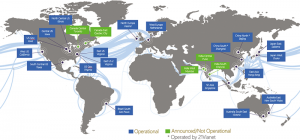
70-534 - Azure Datacentres
The second post of many more to come to help you understand and pass the Architecting Microsoft Azure Solutions exam and gain that sort after certification.
Well first things first, lets cover off the Microsoft Azure Datacentres. The datacentres may be known as Azure GFS datacentres (Global Foundation Services) or they were newly renamed to Microsoft Cloud Infrastructure and Operations (MCIO).
Microsoft’s Azure datacentres are in all 17 different regions throughout the world all networked together with access available to these datacentres from 140 different countries. They are operate in 10 different languages and 24 different currencies. Not only can you run your servers and applications in these datacentres, they also are used by Microsoft to deliver their own services, like Office 365 services, Bing search, Xbox live as well as the Azure platform. These datacentres are huge (some as big as three large cruise ships placed end to end) with over one million servers serving over one billion customers. They have to be to provide infrastructure to themselves as well as all their clients around the world with real time replication, low latency and very very high reliability.
The regions they are available in are;
Azure Region Location
Central US Iowa
East US Virginia
East US 2 Virginia
US Gov Iowa Iowa
US Gov Virginia Virgina
North Central US Illinois
South Central US Texas
West US California
North Europe Ireland
West Europe Netherlands
East Asia Hong Kong
Southeast Asia Singapore
Japan East Tokyo, Saitama
Japan West Osaka
Brazil South Sao Paulo State
Australia East New South Wales
Australia South East Victoria
Central India Pune
South India Chennai
West India Mumbai
Choosing a Microsoft Azure Datacentre
Whenever choosing a datacentre to build your environment in, its always best practice to choose the one that is closest to your users, this will help with any latency, performance and reliability issues. Not all of the Microsoft Azure datacentres share the same set of services. (Microsoft regularly roll out new services. To see which services are available and where, visit the Microsoft website https://azure.microsoft.com/en-us/regions/services/). Australia has an additional constraint that only customers residing within Australia and New Zealand can uses the services within that region. Additionally, China which you may have noticed isnt specified above, delivers Azure services independently from the others as it is offered by one of their largest Internet Service Providers, 21Vianet. Data within the China Azure infrastructure remains within China and doesnt replicate or share data to the other regions.
Azure Datacentre Resiliency

Having datacentres that big and making them highly available creates a huge problem. Just think about having to manage over one million servers, patching them, updating firmware, replacing failed hardware. The number of servers alone is enough to make the average administrator faint. The advantage that Azure has over the average datacentre is, the amount of physical hardware servers. When one server starts to fail, its virtual machines can be migrated to another healthy server. Faults are detected and migration is handled automatically. The ability to quickly recover, or in most instances, migrate these virtual machines live, means high resilience is built in. This is known as Mean Time to Recover (MTTR), which allows Microsoft to provide the availability of services to their customers, quickly and without user intervention.
Azure Security

Microsoft takes security of seriously. Imagine all the data belonging to all these customers and Microsoft have a rogue employee start stealing data. Well Microsoft has locked down Azure only so that the administrators only have enough access and time to do the task they require. This is known as Just in Time Administrator Access. By default, Microsoft administrators do not have access to customer data and can only gain access when granted by the client and only during a predetermined window. All their administrator access and actions are logged, monitored and audited. Physical access to the Microsoft Azure Datacentres and hardware is also monitored with continuous surveillance.
As you can imagine, Microsoft Azure datacentres would be a target for all sort of nefarious type of hackers and threats. Threat management is also provided as part of the service. Data is scrubbed and monitored for any potential threats prior to it coming in to your precious servers. Intrusion detection, Denial of Service attack prevention, regular penetration testing, data analytics and machine learning tools help to keep your servers and data safe. Azure scans all software during all physical server builds. They also have real time protection and on demand scanning of their cloud services and virtual machines.
Deployment of patching is automated to the Azure infrastructure. Patching deployment is based on the severity of the patch. Azure will also patch customers virtual machines unless the customer has requested to manually patch their systems themselves (ie using SCCM or WSUS or the like).
Having so many customers share infrastructure between them in the multitenant environment, could be a huge security risk. Azure logically isolates each customer from each other so that no customer should be able to access any other customers data. For customers own security and compliance, Microsoft Azure provides a set of tools to help the client achieve this. Azure offers technology like data encryption in transit and at rest (Azure storage is encrypted). Azure also obtains some of the highest security certifications, such as ISO27001 and ISO27002,
HIPPA, FISMA, FedRAMP etc (The Microsoft Azure Trust Centre details the certifications held further. Please visit https://www.microsoft.com/en-us/trustcenter/Compliance for more information).
Azure Datacentre Designs

With so many datacentres that are this large and with so many customers utilising their services and expecting reliability and performance, every Azure datacentre is designed with infrastructure availability as the main concern. Every critical component of Azure is built with redundancy in mind. Multiple Uninterruptible Power Supplies (UPS), huge arrays of batteries and large generators with fuel reserves to compensate in case of a tremendous disaster.
As you can imagine, running each of these datacentres is a huge expense for Microsoft. So each datacentre is also designed with to lower their total cost of ownership. Each of the Azure datacentres operate with a lower Power Usage Effectiveness (PUE) rating as low as 1.125, in comparison an average datacentre PUE rating is an 1.8. A low PUE means that the datacentre consumes less power and Microsoft achieve this by looking at the datacentre as a whole, not just focusing on each single component.
Azure Datacentre FAQs
| Question | Answer |
|---|---|
What are Microsoft Azure Datacentres? | Microsoft Azure Datacentres are facilities that house and maintain servers and other infrastructure for running applications and services on the Azure platform. They are located in 17 different regions throughout the world and are used by Microsoft to deliver their own services as well as provide infrastructure to clients around the world. |
What are the regions in which Microsoft Azure Datacentres are available? | Microsoft Azure Datacentres are available in 17 different regions around the world, including Central US, East US, West US, North Europe, West Europe, East Asia, Southeast Asia, Japan East, Japan West, Brazil South, Australia East, Australia South East, Central India, South India, and West India. |
How do I choose a Microsoft Azure Datacentre? | When choosing a Microsoft Azure Datacentre to build your environment in, it’s best practice to choose the one that is closest to your users to improve latency, performance, and reliability. Not all of the datacentres share the same set of services, so it’s important to check which services are available and where on the Microsoft website. Additionally, customers residing within Australia and New Zealand can only use the services within the Australia region. |
What is Azure Datacentre Resiliency? | Azure Datacentre Resiliency refers to the high resilience built into Microsoft’s Azure datacentres, which allows virtual machines to be quickly recovered or migrated live to another healthy server in the event of a failure. Faults are detected and migration is handled automatically, resulting in a Mean Time to Recover (MTTR) that allows Microsoft to provide the availability of services to their customers quickly and without user intervention. |
How does Microsoft ensure the security of its Azure Datacentres? | Microsoft takes the security of its Azure Datacentres seriously, and has implemented measures such as Just in Time Administrator Access, physical access monitoring, and continuous surveillance to prevent unauthorized access. Threat management is also provided as part of the service, which includes intrusion detection, Denial of Service attack prevention, regular penetration testing, data analytics, and machine learning tools to help keep customers’ servers and data safe. Azure logically isolates each customer from each other to reduce the risk of security breaches in the multi-tenant environment. |
Well thats enough for the moment. I will continue on to the next blog post for the 70-534 exam another day.
Leave a Reply Cancel reply
You must be logged in to post a comment.


